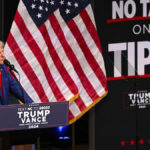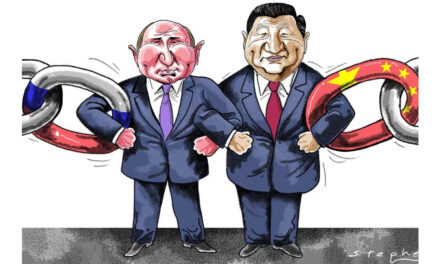
How Gorbachev and Reagan changed the world

You either have to be my age or an avid student of world history to know how the Leader of the Union of Soviet Socialist Republics and the President of the United States of America changed the world order. In fact, you must be my age to know what the Soviet Union was in those days.
What occurred in the 1980s was among the three most important changes to the world order of the 20th Century – they are President Truman’s ending World War II and the founding of NATO, President Nixon bringing China out from under the so-called “Bamboo Curtain” and President Reagan’s bringing down the “Iron Curtain” that isolated the Soviet Union from the civilized world.
Soviet Leader (and dictator) Mikhail Sergeyevich Gorbachev was the antagonist to Reagan as was China’s Mao Zedong to Nixon. The parallels were noteworthy as both communist nations were self-isolated from the world – although both were allies-of-convenience in WW II.
The one major difference was that while China came out from behind the Bamboo Curtain as a nation, the old Soviet Union was an empire that collapsed and deconstructed in a spectacular – literally unbelievable – manner. Most of what was called the “Captive Nations” of the Soviet Union were liberated – and many declared independence. Some even joined NATO – the alliance to defend Europe against Soviet aggression.
In the days of my youth, Russia was an isolated nation headed by ruthless dictators determined to bring down the United States economically or militarily. The WW II alliance between President Franklin Roosevelt and Soviet Leader Joseph Stalin ended with the surrender of Germany.
I was a child when the USSR became the second nuclear nation – pointing its missiles at the United States. The Cold War was on. The concept of “mutual assured destruction” (MAD) restrained both nations – but just in case, we students regularly received instructions about what we should do if we were to see a “big flash of bright light.” We would immediately crouch under our desks – as if that would have made any difference.
As with China, we knew very little about the Soviet Union. There was no tourism, no exchange students, not business relationships. If MAD prevented a nuclear war, the Cold War was one of intrigue and espionage. American leaders were more concerned about the infiltration of communists into our basic institutions rather than rockets flying over the Atlantic Ocean.
In some cases, the ferreting out of communist “fellow travelers” reached witch hunt proportions – but there was enough spy-versus-spy to legitimize concern. In fact, the secrets to the construction of the atomic bomb were provided to Russia by a husband-and-wife team of traitors.
California Congressman Richard Nixon gained national prominence and the vice presidency because of his tracking down Soviet sympathizers. It has always been considered no small irony that one of the most anti-communist leaders in America would be the guy to normalize relations with — as we called it – Red China.
China and Russia were both adversaries of the United States, but the Soviet Union stood out … first because they had THE BOMB and second they were aggressively pursuing empire expansion – confronting American leadership diplomatically and in “proxy skirmishes.”
I can recall watching on my small screen black-and-white television as Soviet Premier Nikita Khrushchev pounds the table with his shoe and later threatened to “bury” the United States. I can recall the face-to-face “kitchen debate” in which Nixon shook his scolding finger at Khrushchev. The “kitchen” was a trade show display in Moscow.
During those days – and despite MAD — there was a general belief that eventually there would be another world war pitting the authoritarian communist world against the free-market democratic republics.
Enter Reagan
Reagan entered office in 1981. He and his friend and Secretary of Defense Casper Weinberger developed a plan to crush the Soviet Union. While past administrations had operated under a “containment policy” that tended to normalize each new advance by Moscow, Reagan and Weinberger were determined to push them back. (As a friend of Weinberger, I was privileged to have a unique personal insight to events of those days.)
Cracks were developing in the Soviet regime. Isolation and military aggressions are hard on an economy. The Space Race and the U.S. military buildup – with the threat of the Star Wars defense system — forced Russia to compete — a move that broke the Soviet economy.
When Reagan took office, the Soviet Leader was hardliner Yuri Andropov – but only for three more years. He was succeeded by Konstantin Chernenko, who only lasted one year.
Enter Gorbachev
Gorbachev was different than his predecessors – more interested in normalizing relations with the greater world community, especially the United States. He was an advocate for “glasnost” (openness and transparency) – moving away from the super secretive nature of Soviet governance. Gorbachev accelerated “perestroika” – which was a shift away from central economic planning to a more competitive approach.
Gorbachev also promoted free elections with multiple parties and an elected office of President – replacing the system in which the Communist Party Leader was the Leader of the Soviet Union. This created a political struggle between Gorbachev and an up-and-comer reformer Boris Yeltsin, the First Secretary of the Moscow City Committee (aka the mayor).
But it was the nature of the relationship between Gorbachev and Reagan that would end the Soviet Union. If there was a moment of note, it was the 1986 Reykjavík Summit meeting in Iceland between the two leaders. While no formal agreements were reached, Reagan had been forceful in putting nuclear disarmament on the table – and for the first time raised the issue of human rights.
Ironically, Gorbachev and Reagan gained a level of admiration for each other. A friendship that lasted until Reagan’s death in 2004.
Most empires end in conquest – or slowly drift away as power ebbs. The Soviet empire collapsed suddenly. It seemed like a one-day event. The Soviet Union exists one day – and the next, virtually all the nations it occupied and ruled over are set loose. It was an era of declarations of independence from Moscow.
I had the honor to be working with the Lithuanian government shortly after that country declared independence from Moscow. During my visit, Russian troops were still bivouacked in the forests outside of Vilnius. The sandbags were still in the windows of the government buildings. And with Russia still controlling the gas lines, the inside of buildings – including the office of the new President and Vice President – was chilly. At night we had to sleep wearing our outdoor winter clothes. However, the joy of freedom was seen and felt everywhere. That visit would never have been possible without Reagan and Gorbachev.
At the time of the Soviet collapse, there was a KGB operative stranded in East Germany. As he saw his Mother Russia’s empire denigrated, he was filled with extreme bitterness and ambition … a bitterness and ambition that has driven his life since then.
Enter Vladimir Putin.
So, there ‘tis.




























And that operative’s name was Vladimir Putin. I remember it all, including the nuke drills in school where we rushed to the basement to avoid the blasts. In many ways it was the best of times and the worst of times. Putin hated Yeltzin and considered him a worthless alcoholic. And how can we ever forget McCartheism and the witch hunts that stole the personal freedoms of many Americans.
I think it’s really cool you hung with Caspar, did he offer to sterilize your kids? Sorry, black humor, pun intended. But you didn’t know that then, and really cool you knew him. My contacts all came from the White House staff so I have more of a service-worker view. Like Nixon was really nice, and always new your name, family, etc. and Carter — jump into a closet, the man is intense…..
But I digress.
Reagan did this, that’s history. But even Reagan was surprised and shocked by the fall. And frankly, no matter the verbal hard line, the programs still emphasized containment. Example would be KAL 007 shot down by Russia with over 250 souls, close to 70 Americans. Reagan provided rhetoric, no physical response. There are other examples too.
But he did it, it’s history. My biggest issue is that we were playing chicken in the arms race, we had no real intelligence, and it appears it was a surprise to Reagan, meaning pure dumb luck we pulled it off. But unintended outcomes are grand when they fall your way.
Like you, still have my under the desk memories, along with playing Ho Chi Ming Trail style cowboys and Indians, and my 50-years Soviet Union commemorative pin I got at the embassy. In those days, I felt Russia’s rulers were corrupt and sinful, but people probably OK. But starting in the 80’s, my world-traveling FIL, combined with my growing foreign experiences, convinced me —- nah, there’s a real issue with the Soviet culture all the way to the man on the street. Too many years of this crap.
Liked this one though, good story.
We were told to put our heads between our knees if we saw a bright flash and super wind. I got sent to the office when I asked if we were to kiss our ass goodbye.
Frank Stetson. When folks tell you that they were planning to crush the Soviet Union — and how were going about it — I do not call it dumb luck when they succeed. And unless you have had conversations with Reagan, you need to know that he was not surprised. He was involved in the process step-by-step. He knew the Soviet Union would soon collapse and the Berlin Wall would come down even though the inevitable happened on George Bush’s watch. Reagan was the best foreign policy President of the 20th Century — and so far into the 21st.